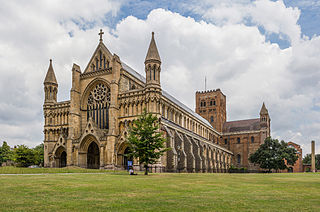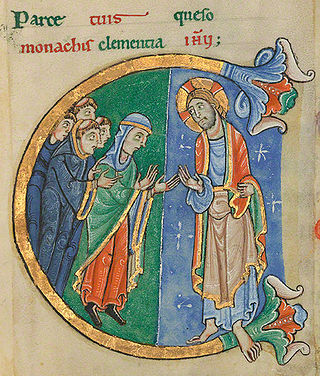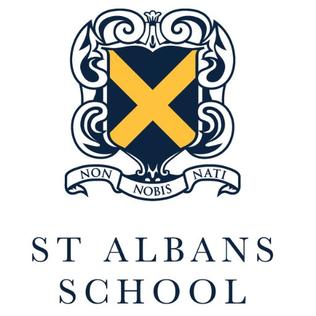
St Albans Cathedral, officially the Cathedral and Abbey Church of St Alban but often referred to locally as "the Abbey", is a Church of England cathedral in St Albans, England.

Matthew Paris, also known as Matthew of Paris, sometimes confused with the nonexistent Matthew of Westminster, was an English Benedictine monk, chronicler, artist in illuminated manuscripts, and cartographer who was based at St Albans Abbey in Hertfordshire. He authored a number of historical works, many of which he scribed and illuminated himself, typically in drawings partly coloured with watercolour washes, sometimes called "tinted drawings". Some were written in Latin, others in Anglo-Norman or French verse.
Thomas Walsingham was an English chronicler, and is the source of much of the knowledge of the reigns of Richard II, Henry IV, Henry V and the latter reign of Edward III depicting the decline of the state of affairs of the English. He also documented the careers of John Wycliff and Wat Tyler.
Roger of Wendover, probably a native of Wendover in Buckinghamshire, was an English chronicler of the 13th century.

The Flores Historiarum is the name of two different Latin chronicles by medieval English historians that were created in the 13th century, associated originally with the Abbey of St Albans.

Christina of Markyate was born with the name Theodora in Huntingdon, England, about 1096–1098 and died about 1155. She was an anchoress, who came from a wealthy English family trying to accommodate with the Normans at that time. She later became the prioress of a community of nuns.

St Albans School is a public school in the city of St Albans in Hertfordshire. Entry before Sixth Form is for boys only, but the Sixth Form has been co-educational since 1991. Founded in 948 by Wulsin, St Albans School is not only the oldest school in Hertfordshire but also one of the oldest in the world. The school has been called "Britain's oldest public school" by the Daily Mail. Nicholas Carlisle, in 1818, described the school as "of very ancient origin, and of great celebrity" and the Good Schools Guide describes St Albans as a "traditional public school, with a rich history".
Sopwell Priory was a Benedictine nunnery founded around 1140 on the site of an ancient hermitage in Sopwell, Hertfordshire, England. After the Dissolution, the priory was torn down and a Tudor manor house constructed in its place.

Richard of Wallingford (1292–1336) was an English mathematician, astronomer, horologist, and cleric who made major contributions to astronomy and horology while serving as abbot of St Albans Abbey in Hertfordshire.
Wallingford Priory was a Benedictine priory dedicated to the Holy Trinity in Wallingford in the English county of Berkshire. Nothing remains of Holy Trinity Priory, which is believed to have stood on the site of the Bullcroft recreation ground off the High Street.
William of Wallingford was the 47th abbot of St Albans Abbey. He was a Benedictine monk at Holy Trinity Priory, Wallingford, Berkshire, England and like John of Wallingford and Richard of Wallingford, moved from this cell of St Albans Abbey to the abbey itself. He was a favourite of John Stoke, 44th abbot of St Albans, also from Wallingford. On his deathbed in 1451, Stoke was supposed to have given William and Thomas Wallingford, his senior chaplain, charge over 1000 marks but after his death they could only account for 250 marks. The abbot John Wheathampstead who succeeded Stoke suspected the two over the money. Nevertheless, William of Wallingford was later appointed abbot in 1476, after the death of William Albone, apparently for his financial acumen, at a time when the abbey was in debt. William of Wallingford managed to get rid of the debt whilst also spending on the abbey. He built the high altar known as the Wallingford Screen at a cost of £733 and completed the chapter house. The statues on it were destroyed during the Dissolution but were replaced in Victorian times.

The Liberty of St Albans was a liberty situated within Hertfordshire, but enjoying the powers of an independent county. It was originally associated with the abbey of St Albans, and later with the borough corporation. It was absorbed by Hertfordshire in 1874. It was also known as the Hundred of Cashio.

Paul of Caen was a Norman Benedictine monk who became fourteenth Abbot of St Albans Abbey in 1077, a position he held to 1093. He was a nephew of Archbishop Lanfranc.
Richard de Morins, also known as Richard of Mores, Richard de Mores, Ricardus de Mores, and Ricardus Anglicus was an English Augustinian canon of Merton Priory, before becoming prior at Dunstable Priory in 1202.
This is a list of abbots of St Albans Abbey up to its Dissolution in 1539.
- Willegod (793–796)
- Eadric
- Wulsig
- Wulnoth (Walworth)
- Eadfrith
- Wulsin
- Aelfric
- Ealdred
- Eadmer
- Leofric
- Ælfric of Abingdon
- Leofstan
- Frithric (Frederic)
- Paul of Caen (1077–1093)
- Richard d'Aubeney (1097–1119)
- Geoffrey of Dunstable (1119–1146)
- Ralph Gubion (1146–1151)
- Robert de Gorron (1151–1166)
- Symon (1167–1183)
- Warin (1183–1195)
- John de Cella (1195–1214)
- William of Trumpington (1214–1235)
- John of Hertford (1235–1263)
- Roger de Norton (1263–1291)
- John of Berkhamsted (1291-1302)
- John de Maryns (1302–1308)
- Hugh of Eversden (1308–1327)
- Richard of Wallingford (1326–1335)
- Michael of Mentmore (1335–1349)
- Thomas de la Mare (1349–1396)
- John de la Moote (1396–1401)
- William Heyworth (1401–1420)
- John of Wheathampstead (1420–1440)
- John Stoke (1440–1451)
- John of Wheathampstead (1451–1465)
- William Albon (1465–1475)
- William of Wallingford (1476–1492)
- Thomas Ramryge (1492–1520)
- Thomas Wolsey (1521-1529/1530), Commendatory abbot
- Robert Catton (1529–1538)
- Richard Boreman alias Stevenage (1538–1539), last abbot

Geoffrey de Gorham, sometimes called Geoffrey of Dunstable or of Le Mans, was a Norman scholar who became Abbot of St Albans Abbey, 1119 to 1146.

John of Wallingford was a Benedictine monk at the Abbey of St Albans, who served as the abbey's infirmarer at some time between c.1246-7 and his death in 1258. He is now mostly known through a manuscript containing a miscellaneous collection of material, mostly written up by Wallingford from various works by his contemporary at the abbey Matthew Paris, which survives as British Library Cotton MS Julius D VII. This manuscript includes the so-called Chronica Joannis Wallingford or Chronicle of John of Wallingford.
William Binham was an English theologian and Benedictine prior of Wallingford in Berkshire. He took the degree of D.D. at Oxford, where he was for a time intimate with Wycliffe, against whom he afterwards wrote Contra Positiones Wiclevi.
Simon Binham or Bynham was an English chronicler and Benedictine monk of the priory of Binham, Norfolk. He assisted the prior of Binham in opposing the exactions of Hugh, abbot of St. Albans, and was imprisoned for some time with the other rebellious monks. He is said to have contributed to the continuation of the Chronicle of Rishanger, but his other writings are largely lost.









